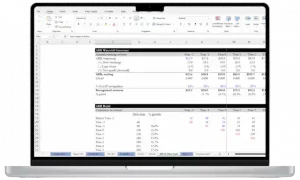Private equity case studies are an important part of the private equity recruiting process because they allow firms to evaluate a candidate’s analytical, investing, and presentation abilities.
In this article, we’ll look at the various types of private equity case studies and offer advice on how to prepare for them.
This guide will help you ace your next private equity case study, whether you’re a seasoned analyst or new to the field.
Types Of Private Equity Case Studies
Case studies are very common in private equity interviews, and they are a key part of the overall recruiting process.
While you’re extremely likely to encounter a case study of some kind during your recruiting process, there is considerable variety in the types of case studies you might face.
Below I cover the major types:
- Take-home assignment
- In-person LBO modeling assignment
- Paper LBO
Take-home assignment
For this case study, you’ll get some company information (e.g. a 10-K or a CIM) and be asked to assess whether or not you’re likely to invest.
Generally, you’ll get between 2-7 days to prepare a full presentation or investment memo with your recommendations that you’ll present to the interviewer. To support your investment recommendation, you’ll be expected to complete a full LBO model. The prompt may give certain details or assumptions to include in the model.
This type of test is most common during “off-cycle” hiring throughout the year, since firms have more time to allow you to complete the assignment.
In-person LBO modeling assignment
This is pretty similar to the take-home assignment. You’re given company materials, will build a financial model, and decide whether you would invest.
The difference here is the time you’re given to complete the case. You’ll generally get between two to three hours, and you’ll typically complete the case study in the firm’s office, though some firms are becoming newly open to completing the assignment remotely.
In this case, you’ll typically only complete an LBO model. There is usually no presentation or investment memo. Rather, you’ll do the model and then have a short discussion afterward.
Paper LBO
This is a shorter, more condensed version of an LBO model. You can complete a paper LBO with a piece of paper and a pen. Alternatively, you may be asked to discuss it verbally with the interviewer.
Rather than using an Excel spreadsheet, you use an actual sheet of paper to show your calculations. You don’t go into all the detail but focus on the essence of the model instead.
In this article, we’ll be focusing on the first two types of case studies because they are the most widely used. But if you’re interested, here is a deep dive on Paper LBOs.
Private Equity Case Study Prompt
Regardless of the type of case study you’re asked to do, the prompt from the interviewer will ultimately ask you to answer: “would you invest in this company?”
To answer this question you’ll need to take on the provided materials about the company and complete a leveraged buyout model to determine whether there is a high enough return. Generally, this is 20% or higher.
Usually, prompts also provide you with certain assumptions that you can use to build your LBO model. For example:
- Pro forma capital structure
- Financial assumptions
- Acquisition and exit multiples
Some private equity firms provide you with the Excel template needed for an LBO model, while others prefer you to make one from scratch. So be ready to do that.
Private Equity Case Study Presentation
As you’ve seen above, if you get a take-home assignment as a case study, there’s a good chance you’re going to have to present your investment memo in the interview.
There will usually be one or two people from the firm present for your presentation.
Each PE firm has a different interview process, some may expect you to present first and then ask questions, or the other way around. Either way, be prepared for questions. The questions are where you can stand out!
While private equity recruitment is there to assess your skills, it’s not all about your findings or what your model says. The interviewers are also looking at your communication skills and whether you have strong attention to detail.
Remember, in the private equity interview process, no detail is too small. So, the more you provide, the better.
How To Do A Private Equity Case Study
Let’s look at the step-by-step process of completing a case study for the private equity recruitment process:
- Step 1: Read and digest the material you’ve been given. Read through the materials extensively and get an understanding of the company.
- Step 2: Build a basic LBO model. I recommend using the ASBICIR method (Assumptions, Sources & Uses, Balance Sheet, Income Statement, Cash Flow Statement, Interest Expense, and Returns). You can follow these steps to build any model.
- Step 3: Build advanced LBO model features, if the prompts call for it, you can jump to any advanced features. Of course, you want to get through the entire model, but your number 1 priority is to finish the core financial model. If you’re running out of time, I would skip or reduce time on advanced features.
- Step 4: Take a step back and form your “investment view”. I would try to answer these questions:
- What assumptions need to be present for this to be a good deal?
- Under what circumstances would you do the deal?
- What is the biggest risk in the deal? (e.g. valuation, growth, and margins).
- What is the biggest driver of returns in the deal? (e.g. valuation, growth, and debt paydown).

- 66 lessons
- 12+ video hours
- Excels & templates
How To Succeed In A Private Equity Case Study
Here are a few of my tips for getting through the private equity fund case study successfully.
Get the basics down first
It’s very easy to want to jump into the more complex things first. If you go in and they start asking you to complete complex LBO modeling features like PIK preferred equity, getting to that might be on the top of your list.
But I recommend taking a step back and starting with the fundamentals. Get that out the way before moving on to the complicated stuff.
The fundamentals ground you, getting you through the things you know you can do easily. It also gives you time to really think about those complex ideas.
Show nuanced investment judgment; don’t be too black-and-white
When giving your investment recommendation for a private equity fund you shouldn’t be giving a simple yes or no.
It’s boring and gives you no space to elaborate. Instead, go in with what price would make you interested in investing and why. Don’t be shy to dig in here.
Know where there is a value-creation opportunity in the deal, and mention the key assumptions you need to believe to create that value.
Additionally, if you are recommending that the investment move forward then bring up things you would want to know before closing a deal. You can highlight the key risks of the investment, or key things you’d want to ask management if you could meet with them.
At the end of the day, financial modeling is a commodity skill. Every investor can do it. What will really set you apart is how you think about the deals, and the nuance you bring to analyzing them.
You win by talking about the model
Along those lines, you don’t win by building the best model. Modeling is just a check-the-box thing in the interview process to show you can do it. The interviewers need to know you can do the basics with no glaring errors.
What matters is showing that you can discuss the investment intelligently. It’s about bringing a sensible recommendation to the table with the information to back it up.
How Do I Prepare For A Private Equity Case Study?
There is no one-size-fits-all when it comes to preparing for a private equity case study. Everyone is different.
However, the best thing you can do is PRACTICE, PRACTICE, and more PRACTICE!
I know of a recent client that successfully obtained an offer from multiple mega funds. She practiced until she was able to build 10 LBO models from scratch without any errors or help … yes, that’s 10 models!
Now, whether it takes 5 or 20 practice case studies doesn’t matter. The whole point is to get to a stage where you feel confident enough to do an LBO model quickly while under pressure.
There is no way around the pressure in a private equity interview. The heat will be on. So, you need to prepare yourself for that. You need to feel confident in yourself and your capabilities.
You’d be surprised how pressure can leave you stumped for an answer to a question that you definitely know.
It’s also a good idea to think about the types of questions the private equity interviewer might ask you about your investment proposal. Prepare your answers as far as possible. It’s important that you stick to your guns too when the situation calls for it, because interviewers may push back on your answers to see how you react..
You need to have your answer to “would you invest in this company?” ready, and also how you got to that answer (and what new information might change your mind).
Another thing that gets a lot of people is limited time. If you’re running out of time, double down on the fundamentals or the core part of the model. Make sure you nail those. Also, you can make “reasonable” assumptions if there’s information you wish you had, but don’t have access to. Just make sure to flag it to your interviewer
FAQ
How important is modeling in a private equity case study?
Modeling is part and parcel of private equity case studies. Your basics need to be correct and there should be no obvious mistakes. That’s why practicing is so important. You want to focus on the presentation, but your calculations need to be correct first. They do, after all, make up your final decision.
How can I stand out from other candidates?
Knowing your stuff covers the basics. To stand out, you need to be an expert in showing how you came to a decision, a stickler for details, and inquisitive. Anyone can do the calculations with practice, but someone who thinks clearly and brings nuance to their discussion of the investment will thrive in interviews.
Conclusion
Private equity case studies are a difficult but necessary part of the private equity recruiting process. Candidates can demonstrate their analytical abilities and impress potential employers by understanding the various types of case studies and how to approach them.
Success in private equity case studies necessitates both technical and soft skills, from analyzing financial statements to discussing the investment case with your interviewer.
Anyone can ace their next private equity case study and land their dream job in the private equity industry with the right preparation and mindset.
If you’re looking to learn more about private equity, you can read my recommended Private Equity Books.


 Break Into Growth Equity
Break Into Growth Equity

